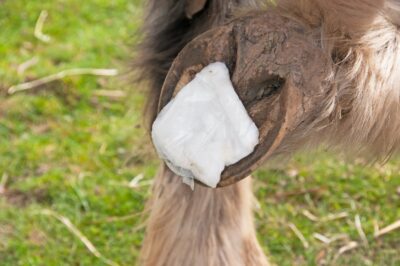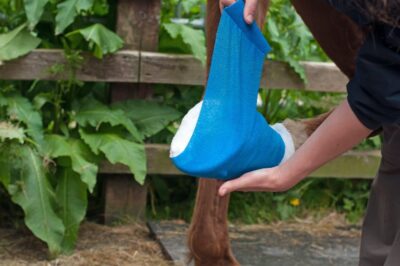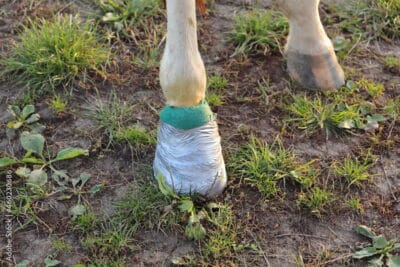Featured, First Aid, Lameness, Veterinary, Wound Care
How and when should I use a poultice on my horse?
Rebecca Watson MSc RVN, discusses all things ‘equine poultice’
A poultice is described as a soft, moist, mass of material which is applied to the body to relive soreness, inflammation and to ‘draw out’ pus or infection. Due to the size and shape of our horses (and therefore the difficulty in securing a poultice in place) we tend to use them only on the limbs and hooves of the horse. Poultices can have a cooling or heating effect, depending on the ingredients used and how they are applied.
Cold poultice
Cold poultices are good for acute injuries, soreness, and inflammation of the limbs, after exercise for example, as a form of cold therapy. Although cold hosing and ice are more effective, they may not always be available; clay based cooling poultices are a good alternative to reduce heat in the limbs of equine athletes after work or competition.
As the moisture in the poultice evaporates, it takes the heat in the limbs with it, providing a cooling effect. The heat from your horse’s legs will eventually warm a poultice, especially if a bandage has been placed over the top. To reduce this warming effect a damp cloth or brown paper can be used over the cooling poultice under the bandage, to keep the area wet and cool for longer. For certain injuries, your veterinary surgeon may recommend a cold poultice for the first few days – the acute stage of the injury, then to alternate between hot and cold, to increase the circulating blood supply at the site of injury and therefore, improve lymphatic drainage.
Hot poultice
Hot poultices are somewhat of a misnomer – rather, they should be ‘warm poultices’. Whether a clay poultice that has been heated up or an ‘Animalintex®’ type poultice that has been prepared with boiling water, care should be taken to ensure the temperature of the poultice has cooled sufficiently to comfortably be applied to the horse’s skin or hoof. Test the temperature on your own arm first. Hot poultices tend to be the go to choice for dealing with drawing out hoof abscesses and treating bruised soles. Do not poultice more of the foot than necessary, as the hoof can become waterlogged, which can weaken the horn. Always be careful when bandaging a hoof poultice in place – you want it secure enough not to fall off, but not so tight that you damage the heels or the coronary band.
Images top to bottom: Cut the poultice to size; Use self adhesive bandage to hold the dressing and padding in place; Cover with duct tape



If using a commercial poultice, such as ‘Animalintex®’, cut the poultice to the size you need, soak the poultice in boiled water and allow it to cool to a temperature that is safe to apply. Apply the poultice to the relevant area of the hoof and cover with cotton gamgee padding or, a baby nappy will also work well. Secure the poultice and the padding with a conforming bandage – with care being taken not to apply too tightly over the bulb of the heels / coronary band. To prevent contamination of the dressing, a layer of duct tape (or similar) over the bottom of the foot is advised.
Hoof abscesses can be quite dramatic in some horses with the first sign of trouble being the horse becoming acutely lame, sometimes described as ‘fracture lame’. If an abscess is suspected, poulticing the hoof can help soften the sole and draw out the pus.
The poultice should be changed after 8-12h, even if it has ‘burst out’ (and the horse is now much more comfortable on the foot) it is a good idea to get your farrier or veterinary surgeon to dig out the abscess, to allow adequate drainage of the infection.
Once the abscess is actively draining there should be significant improvement in soundness of the horse. Continue poulticing the foot – changing the poultice every day – until the abscess has full drained, which usually takes 2-3 days (if the abscess has not drained in this time, it may be necessary for further veterinary investigation / examination of the hoof). A dry poultice can then be placed over the foot for 24-48h afterwards, to give the sole and surrounding tissues a chance to dry up. Monitor the drainage site closely for 7-10 days after dressings have been removed.
If lameness disimproves after the discontinuation of poulticing – a veterinary examination should be sought immediately.
Should you make your own?
Traditionally poultices were homemade, from a clay-type base and incorporated a wide range of commercially available poultices available, for every possible use. There are many recipes available online if you Google – ‘how to make an equine poultice’. However, bear in mind that if your horse is competing, some of the substances you might add to your poultice could be a naturally occurring prohibited substance – which could result in a positive doping test. Best to stick to commercially available poultices in this instance, which are guaranteed competition safe.
Remember also, that it is entirely possible for the horse to have an allergic reaction to any substance that is applied directly to the skin. Some substances, though ‘natural’, may irritate or burn your horse’s skin, so always seek good advice from a reputable source before attempting to make your own poultice.
Cold:
- Post competition (racing / eventing / polo)
- Soreness (of shins, for example)
- Puffy or swollen legs
- Bumps or lumps
- Insect bite or a sting
- Hot spots
Warm:
- Hoof abscesses
- Hoof bruising
- Joint stiffness or arthritis
- Old injuries
How long should you use it for?
The length of time you use a poultice for will depend on the type of injury or ailment you are treating. If there is no sign of improvement within a 24h period – veterinary advice should be sought, you may be dealing with a bigger or more serious problem than you initially thought. Watch out for any swelling above or below the area you are poulticing, a worsening of the lameness or the horse showing signs of fever – elevated temperature, in-appetence, or dullness. If you notice any of these signs, call your veterinary surgeon immediately.
When not to poultice?
Poultices can be used on wounds that are old or dirty to aid the disinfection / cleaning process, but it is advisable to only poultice the area once (after thorough cold hosing / irrigation of the wound to remove the gross contamination / debris), then continue dressing the wound with a normal antibacterial dressing. Prolonged poulticing can make the wound edges oedematous and inhibit or even prevent the healing process.
Fresh lacerations or actively bleeding wounds should not be poulticed. Cold hose or irrigate to clean, then apply a clean, dry dressing and seek veterinary examination immediately. If a foreign body (FB) is suspected, a poultice will not fix the problem. Veterinary examination should be sought as soon as possible to assess the extent of the damage of the penetrating object – even before removal of the FB is attempted.
Laminitic pain should not be confused with the pain of a hoof abscess. If you are unsure, please consult your veterinary surgeon. If poulticing is indicated, laminitic horses need very careful management, softening the sole of a laminitic horse can make the other internal hoof structures less stable and may worsen the existing condition.
